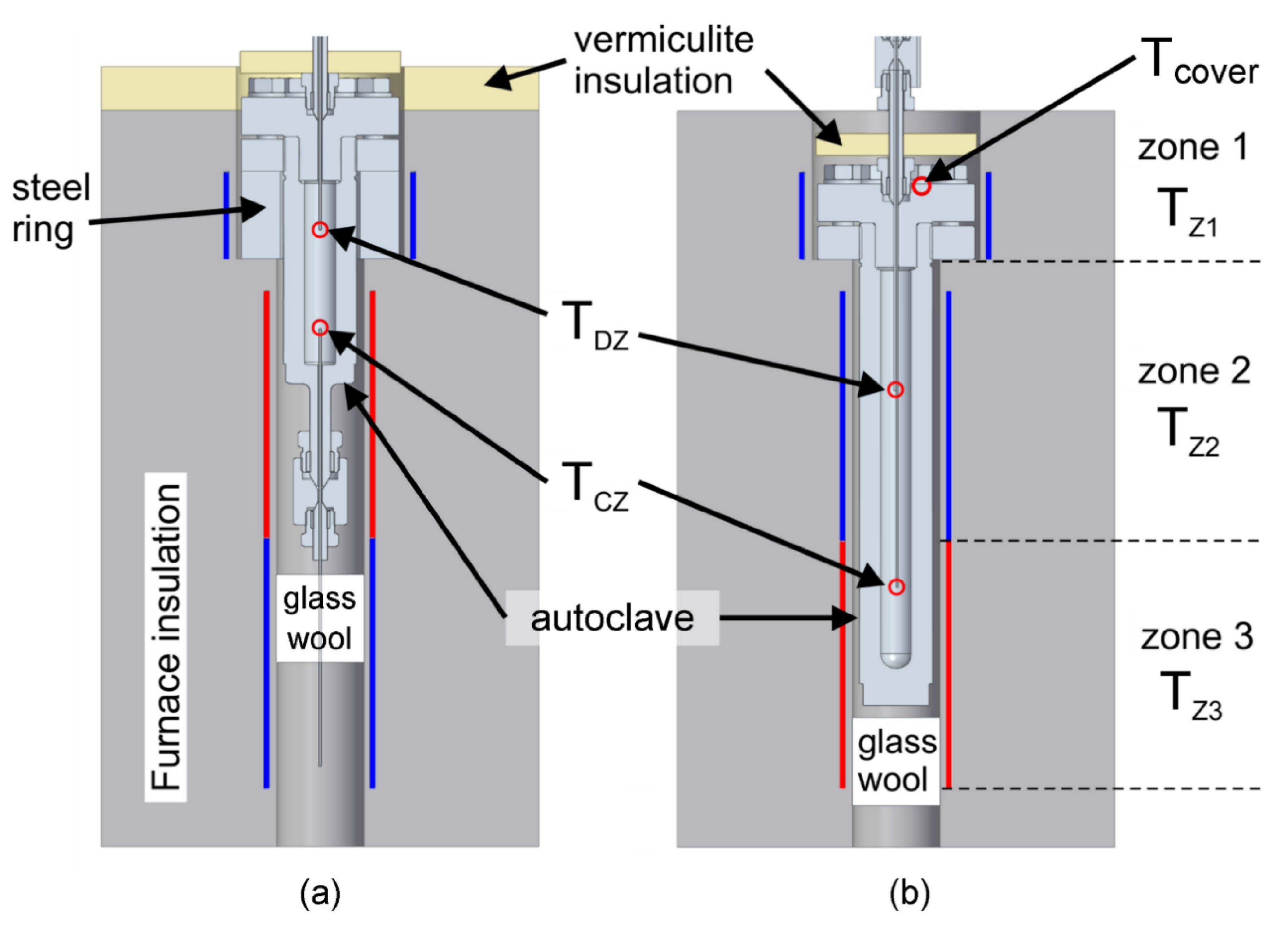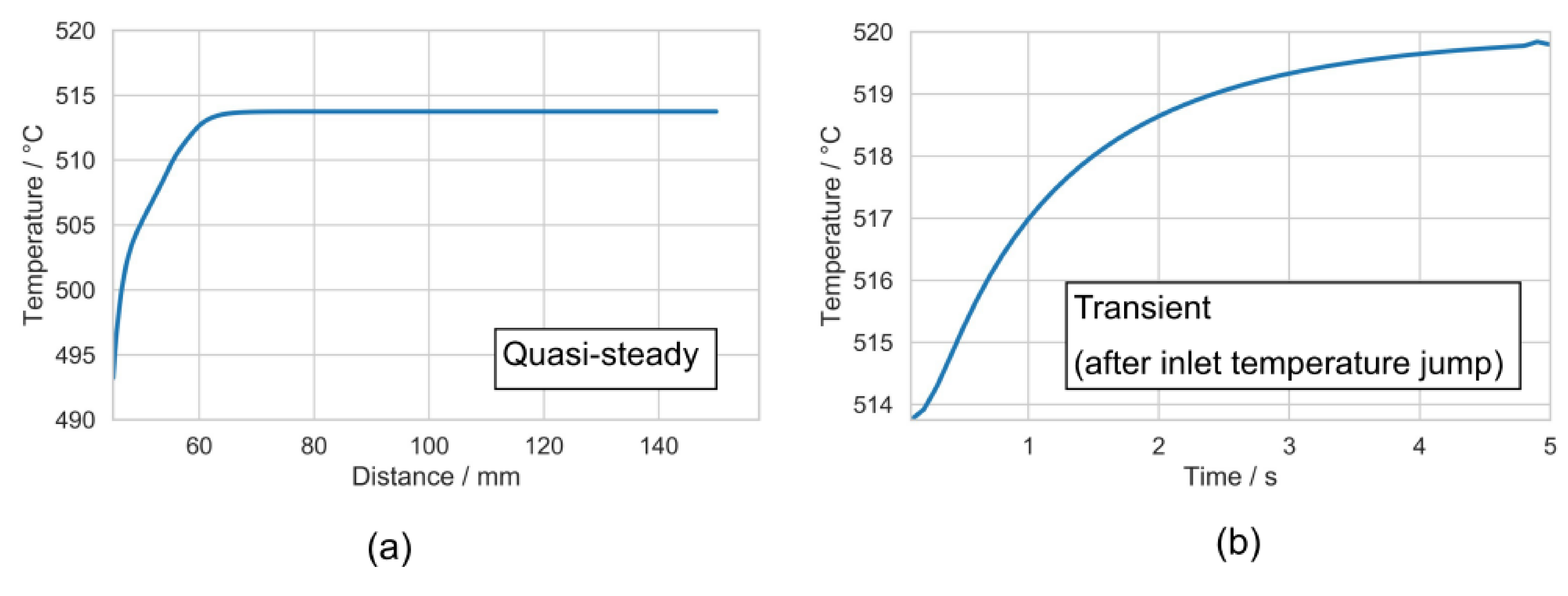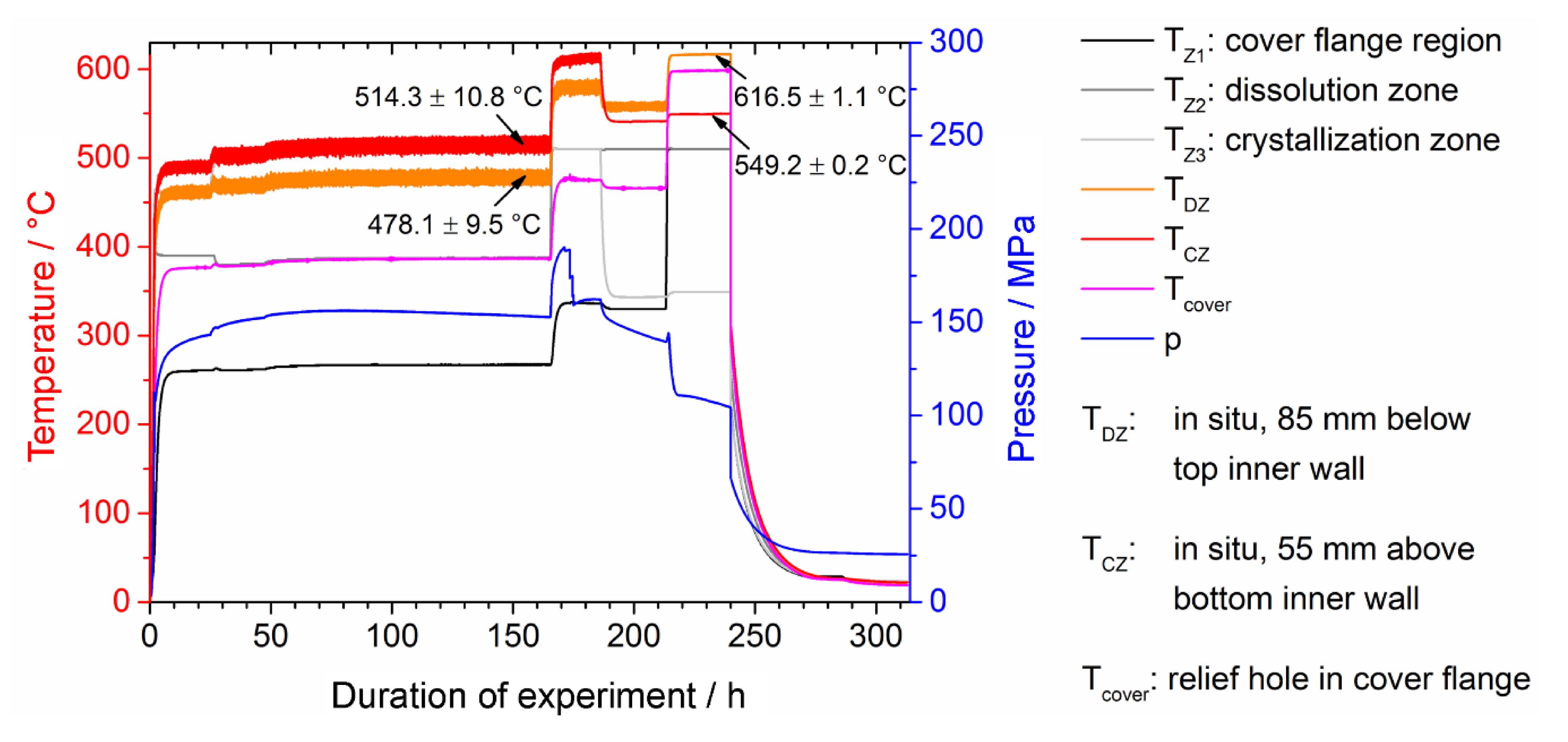Flow Stability, Convective Heat Transfer and Chemical Reactions in Ammonothermal Autoclaves—Insights by In Situ Measurements of Fluid Temperatures
Abstract
1. Introduction
2. Materials and Methods
2.1. Experiments with Internal Temperature Measurements
2.2. Numerical Simulation of Thermocouple Temperature Changes
3. Results and Discussion
3.1. Characterization of the Experiments by Dimensionless Numbers
3.2. Estimate of Thermocouple Response by Numerical Simulation
3.3. Feasibility of Using Temperature Fluctuations as a Probe for Fluid Flow
3.4. Feasibility of Probing Chemical Reactions
3.5. Note on Internal Temperature Measurements Close to Autoclave Walls
4. Conclusions
Author Contributions
Funding
Acknowledgments
Conflicts of Interest
References
- Key, D.; Letts, E.; Tsou, C.-W.; Ji, M.-H.; Bakhtiary-Noodeh, M.; Detchprohm, T.; Shen, S.-C.; Dupuis, R.; Hashimoto, T. Structural and Electrical Characterization of 2” Ammonothermal Free-Standing GaN Wafers. Progress toward Pilot Production. Materials 2019, 12, 1925. [Google Scholar] [CrossRef]
- Zajac, M.; Kucharski, R.; Grabianska, K.; Gwardys-Bak, A.; Puchalski, A.; Wasik, D.; Litwin-Staszewska, E.; Piotrzkowski, R.; Domagala, J.Z.; Bockowski, M. Basic ammonothermal growth of Gallium Nitride—State of the art, challenges, perspectives. Prog. Cryst. Growth Charact. Mater. 2018, 64, 63–74. [Google Scholar] [CrossRef]
- Mikawa, Y.; Ishinabe, T.; Kagamitani, Y.; Mochizuki, T.; Ikeda, H.; Iso, K.; Takahashi, T.; Kubota, K.; Enatsu, Y.; Tsukada, Y.; et al. Recent progress of large size and low dislocation bulk GaN growth. In Proceedings of the Gallium Nitride Materials and Devices XV; Morkoç, H., Fujioka, H., Schwarz, U.T., Eds.; SPIE: Bellingham, WA, USA, 2020; Volume 1128002, p. 1. [Google Scholar]
- Tomida, D.; Bao, Q.; Saito, M.; Osanai, R.; Shima, K.; Kojima, K.; Ishiguro, T.; Chichibu, S.F. Ammonothermal growth of 2 inch long GaN single crystals using an acidic NH4F mineralizer in a Ag-lined autoclave. Appl. Phys. Express 2020, 13, 055505. [Google Scholar] [CrossRef]
- Pimputkar, S.; Kawabata, S.; Speck, J.S.; Nakamura, S. Improved growth rates and purity of basic ammonothermal GaN. J. Cryst. Growth 2014, 403, 7–17. [Google Scholar] [CrossRef]
- Dwiliński, R.; Doradziński, R.; Garczyński, J.; Sierzputowski, L.P.; Puchalski, A.; Kanbara, Y.; Yagi, K.; Minakuchi, H.; Hayashi, H. Excellent crystallinity of truly bulk ammonothermal GaN. J. Cryst. Growth 2008, 310, 3911–3916. [Google Scholar] [CrossRef]
- Häusler, J.; Schnick, W. Ammonothermal Synthesis of Nitrides: Recent Developments and Future Perspectives. Chem. A Eur. J. 2018, 24, 11864–11879. [Google Scholar] [CrossRef] [PubMed]
- Häusler, J.; Neudert, L.; Mallmann, M.; Niklaus, R.; Kimmel, A.C.L.; Alt, N.S.A.; Schlücker, E.; Oeckler, O.; Schnick, W. Ammonothermal Synthesis of Novel Nitrides: Case Study on CaGaSiN3. Chem. A Eur. J. 2017, 23, 2583–2590. [Google Scholar] [CrossRef]
- Häusler, J.; Schimmel, S.; Wellmann, P.; Schnick, W. Ammonothermal Synthesis of Earth-Abundant Nitride Semiconductors ZnSiN2 and ZnGeN2 and Dissolution Monitoring by In Situ X-ray Imaging. Chem. A Eur. J. 2017, 23, 12275–12282. [Google Scholar] [CrossRef] [PubMed]
- Mallmann, M.; Niklaus, R.; Rackl, T.; Benz, M.; Chau, T.G.; Johrendt, D.; Minár, J.; Schnick, W. Solid Solutions of Grimm-Sommerfeld Analogous Nitride Semiconductors II-IV-N2 with II = Mg, Mn, Zn; IV = Si, Ge—Ammonothermal Synthesis and DFT Calculations. Chem. A Eur. J. 2019, 2, 15887–15895. [Google Scholar] [CrossRef] [PubMed]
- Masuda, Y.; Sato, O.; Tomida, D.; Yokoyama, C. Convection patterns and temperature fields of ammonothermal GaN bulk crystal growth process. Jpn. J. Appl. Phys. 2016, 55, 3–6. [Google Scholar] [CrossRef]
- Erlekampf, J.; Seebeck, J.; Savva, P.; Meissner, E.; Friedrich, J.; Alt, N.S.A.; Schlücker, E.; Frey, L. Numerical time-dependent 3D simulation of flow pattern and heat distribution in an ammonothermal system with various baffle shapes. J. Cryst. Growth 2014, 403, 96–104. [Google Scholar] [CrossRef]
- Jiang, Y.N.; Chen, Q.S.; Prasad, V. Numerical simulation of ammonothermal growth processes of GaN crystals. J. Cryst. Growth 2011, 318, 411–414. [Google Scholar] [CrossRef][Green Version]
- Mirzaee, I.; Charmchi, M.; Sun, H. Heat, mass, and crystal growth of GaN in the ammonothermal process: A numerical study. Numer. Heat Transf. Part A Appl. 2016, 70, 460–491. [Google Scholar] [CrossRef]
- Masuda, Y.; Suzuki, A.; Ishiguro, T.; Yokoyama, C. Heat and Fluid Flow in Solvothermal Autoclave for Single-Crystal Growth Process. J. Therm. Sci. Technol. 2012, 7, 379–386. [Google Scholar] [CrossRef][Green Version]
- Alt, N.; Meissner, E.; Schlücker, E.; Frey, L. In situ monitoring technologies for ammonthermal reactors. Phys. Status Solidi Curr. Top. Solid State Phys. 2012, 9, 436–439. [Google Scholar] [CrossRef]
- Griffiths, S.; Pimputkar, S.; Kearns, J.; Malkowski, T.F.; Doherty, M.F.; Speck, J.S.; Nakamura, S. Growth kinetics of basic ammonothermal gallium nitride crystals. J. Cryst. Growth 2018, 501, 74–80. [Google Scholar] [CrossRef]
- Chen, Q.S.; Pendurti, S.; Prasad, V. Effects of baffle design on fluid flow and heat transfer in ammonothermal growth of nitrides. J. Cryst. Growth 2004, 266, 271–277. [Google Scholar] [CrossRef][Green Version]
- Schimmel, S.; Koch, M.; Macher, P.; Kimmel, A.C.L.; Steigerwald, T.G.; Alt, N.S.A.; Schlücker, E.; Wellmann, P. Solubility and dissolution kinetics of GaN in supercritical ammonia in presence of ammonoacidic and ammonobasic mineralizers. J. Cryst. Growth 2017, 479, 59–66. [Google Scholar] [CrossRef]
- Schimmel, S.; Duchstein, P.; Steigerwald, T.G.; Kimmel, A.-C.L.; Schlücker, E.; Zahn, D.; Niewa, R.; Wellmann, P. In situ X-ray monitoring of transport and chemistry of Ga-containing intermediates under ammonothermal growth conditions of GaN. J. Cryst. Growth 2018, 498, 214–223. [Google Scholar] [CrossRef]
- Schimmel, S. In Situ Visualisierung des Ammonothermalen Kristallisationsprozesses mittels Röntgenmesstechnik. Ph.D. Thesis, Friedrich-Alexander-Universität Erlangen-Nürnberg (FAU), Erlangen, Germany, 2018. [Google Scholar]
- Lemmon, E.W.; McLinden, M.O.; Friend, D.G. Thermophysical Properties of Fluid Systems. Linstrom, P.J., Mallard, W.G., Eds.; Available online: http://http//webbook.nist.gov/chemistry (accessed on 5 June 2017).
- Panasiti, M.D.; Lemmon, E.W.; Penoncello, S.G.; Jacobsen, R.T.; Friend, D.G. Thermodynamic properties of air from 60 to 2000 K at pressures up to 2000 MPa. Int. J. Thermophys. 1999, 20, 217–228. [Google Scholar] [CrossRef]
- Kadoya, K.; Matsunaga, N.; Nagashima, A. Viscosity and Thermal Conductivity of Dry Air in the Gaseous Phase. J. Phys. Chem. Ref. Data 1985, 14, 947–970. [Google Scholar] [CrossRef]
- Atroshenko, Y.K.; Strizhak, P.A.; Yashutina, O.S. Determination of necessary time of measurements of surface thermocouples depending on conditions of technological processes. EPJ Web Conf. 2015, 82. [Google Scholar] [CrossRef]
- Spalding, D.B. The PHOENICS Encyclopaedia; Concentration, Heat and Momentum Ltd.: London, UK, 1996. [Google Scholar]
- VDM Metals International GmbH. VDM Alloy 718 Nicrofer 5219 Nb; VDM Metals International GmbH: Werdohl, Germany, 2019; pp. 1–13. [Google Scholar]
- Greene, G.A.; Finfrock, C.C.; Irvine, T.F. Total hemispherical emissivity of oxidized Inconel 718 in the temperature range 300–1000 °C. Exp. Therm. Fluid Sci. 2000, 22, 145–153. [Google Scholar] [CrossRef]
- Lin, Y.S.; Akins, R.G. A Suggested Characteristic Dimension for Natural Convection in Enclosures. Chem. Eng. Commun. 1986, 49, 119–126. [Google Scholar] [CrossRef]
- Krishnamurti, R. Some further studies on the transition to turbulent convection. J. Fluid Mech. 1973, 60, 285–303. [Google Scholar] [CrossRef]
- Pendurti, S.; Chen, Q.S.; Prasad, V. Modeling ammonothermal growth of GaN single crystals: The role of transport. J. Cryst. Growth 2006, 296, 150–158. [Google Scholar] [CrossRef][Green Version]
- Masuda, Y.; Suzuki, A.; Ishiguro, T.; Yokoyama, C. Numerical simulation of heat and fluid flow in ammonothermal GaN bulk crystal growth process. Jpn. J. Appl. Phys. 2013, 52. [Google Scholar] [CrossRef]
- Enayati, H.; Chandy, A.J.; Braun, M.J. Numerical simulations of transitional and turbulent natural convection in laterally heated cylindrical enclosures for crystal growth. Numer. Heat Transf. Part A Appl. 2016, 70, 1195–1212. [Google Scholar] [CrossRef]
- Pai Verneker, V.R.; Krishna Mohan, V. Thermal decomposition of sodium azide. Thermochim. Acta 1977, 21, 375–380. [Google Scholar] [CrossRef]
- Jepsen, L.H.; Wang, P.; Wu, G.; Xiong, Z.; Besenbacher, F.; Chen, P.; Jensen, T.R. Thermal decomposition of sodium amide, NaNH2, and sodium amide hydroxide composites, NaNH2–NaOH. Phys. Chem. Chem. Phys. 2016, 18, 25257–25264. [Google Scholar] [CrossRef]
- Lencka, M.M.; Anderko, A.; Sanders, S.J.; Young, R.D. Modeling viscosity of multicomponent electrolyte solutions. Int. J. Thermophys. 1998, 19, 367–378. [Google Scholar] [CrossRef]
- Abdulagatov, I.M.; Azizov, N.D. Viscosity of aqueous calcium chloride solutions at high temperatures and high pressures. Fluid Phase Equilib. 2006, 240, 204–219. [Google Scholar] [CrossRef]
- Masuda, Y.; Suzuki, A.; Mikawa, Y.; Yokoyama, C.; Tsukada, T. Numerical simulation of natural convection heat transfer in a ZnO single-crystal growth hydrothermal autoclave—Effects of fluid properties. J. Cryst. Growth 2009, 311, 675–679. [Google Scholar] [CrossRef]
- Ferialdi, H.; Lappa, M.; Haughey, C. On the role of thermal boundary conditions in typical problems of buoyancy convection: A combined experimental-numerical analysis. Int. J. Heat Mass Transf. 2020, 159. [Google Scholar] [CrossRef]
- Steigerwald, T.G.; Balouschek, J.; Hertweck, B.; Kimmel, A.-C.L.; Alt, N.S.A.; Schluecker, E. In situ investigation of decomposing ammonia and ammonobasic solutions under supercritical conditions via UV/vis and Raman Spectroscopy. J. Supercrit. Fluids 2018, 134, 96–105. [Google Scholar] [CrossRef]
- Schimmel, S.; Lindner, M.; Steigerwald, T.G.; Hertweck, B.; Richter, T.M.M.; Künecke, U.; Alt, N.S.A.; Niewa, R.; Schlücker, E.; Wellmann, P.J. Determination of GaN solubility in supercritical ammonia with NH2F and NH2Cl mineralizer by in situ X-ray imaging of crystal dissolution. J. Cryst. Growth 2015, 418, 64–69. [Google Scholar] [CrossRef]











| Autoclave Type | Inner Diameter/mm | Inner Length/mm | Aspect Ratio/L | Inner Volume/mL | Wall Thickness/mm |
|---|---|---|---|---|---|
| A | 21.5 | 124 | 5.8 | 47.2 | 14.3 |
| B | 21.0 | 275 | 13.1 | 95.3 | 14.5 |
| Experiment | A1 | A2 | A3 | B1 |
|---|---|---|---|---|
| Autoclave type 2 | A | A | A | B |
| Mineralizer 2 | None | NaN3 | NaN3 | NaN3 |
| cmin/(mmol/mL) 2 | n.a. | 1.00 | 1.00 | 1.14 |
| cGaN,dissolved/(mmol/mL) 2 | n.a. | 1.03 | 14.79 | 8.80 |
| Fluid 2 | Air 4 | Ammonia 3 | Ammonia 3 | Ammonia 3 |
| ρ/(kg/m3) 1,2 | 0.504 | 365 | 416 | 409 |
| cp/(J/(kg·K)) | 1075.3 | 4183.5 | 4110.9 | 4121.2 |
| ν/(m2/s) | 6.80 × 10−5 | 1.297 × 10−7 | 1.271 × 10−7 | 1.265 × 10−7 |
| λ/(W/(m·K)) | 0.0515 | 0.2434 | 0.2855 | 0.2792 |
| Density ρ/(kg/m3) | Specific Heat Capacity cp/(J/(kg∙K)) | Thermal Conductivity k/(W/(m∙K)) | Emissivity ε/(1) |
|---|---|---|---|
| 8260.0 | 533.00 | 20.60 | 0.8 |
| Experiment | A1 (Air) | A2 (NH3,sc) | A3 (NH3,sc) | B (NH3,sc) |
|---|---|---|---|---|
| Grashof | 3.83 × 103 | 3.54 × 107 | 3.77 × 107 | 7.45 × 107 |
| Prantl | 7.16 × 10−1 | 8.14 × 10−1 | 7.61 × 10−1 | 7.64 × 10−1 |
| Rayleigh | 2.74 × 103 | 2.88 × 107 | 2.87 × 107 | 5.69 × 107 |
| Experiment | TZ1/°C Set/ Actual | TZ2/°C Set/ Actual | TZ3/°C Set/ Actual | Tcover/°C | TCZ,in situ/°C | TDZ,in situ/°C | ∇Tinternal/K/cm |
|---|---|---|---|---|---|---|---|
| A1 | 390/390 | 460/460 | -/219 | - | 508.3 ± 0.1 | 448.9 ± 0.1 | 9.1 ± 0.1 |
| A2 | 390/390 | 460/460 | -/244 | - | 477.4 ± 3.1 | 468.9 ± 4.0 | 1.3 ± 1.1 |
| A3 | 390/390 | 460/460 | -/318 | - | 482.2 ± 1.9 | 461.0 ± 1.8 | 3.3 ± 0.6 |
| B | -/261 | 390/390 | 460/460 | 376.5 ± 0.15 | 489.7 ± 7.6 | 461.3 ± 8.6 | 2.1 ± 1.2 |
© 2020 by the authors. Licensee MDPI, Basel, Switzerland. This article is an open access article distributed under the terms and conditions of the Creative Commons Attribution (CC BY) license (http://creativecommons.org/licenses/by/4.0/).
Share and Cite
Schimmel, S.; Kobelt, I.; Heinlein, L.; Kimmel, A.-C.L.; Steigerwald, T.G.; Schlücker, E.; Wellmann, P. Flow Stability, Convective Heat Transfer and Chemical Reactions in Ammonothermal Autoclaves—Insights by In Situ Measurements of Fluid Temperatures. Crystals 2020, 10, 723. https://doi.org/10.3390/cryst10090723
Schimmel S, Kobelt I, Heinlein L, Kimmel A-CL, Steigerwald TG, Schlücker E, Wellmann P. Flow Stability, Convective Heat Transfer and Chemical Reactions in Ammonothermal Autoclaves—Insights by In Situ Measurements of Fluid Temperatures. Crystals. 2020; 10(9):723. https://doi.org/10.3390/cryst10090723
Chicago/Turabian StyleSchimmel, Saskia, Ines Kobelt, Lukas Heinlein, Anna-Carina L. Kimmel, Thomas G. Steigerwald, Eberhard Schlücker, and Peter Wellmann. 2020. "Flow Stability, Convective Heat Transfer and Chemical Reactions in Ammonothermal Autoclaves—Insights by In Situ Measurements of Fluid Temperatures" Crystals 10, no. 9: 723. https://doi.org/10.3390/cryst10090723
APA StyleSchimmel, S., Kobelt, I., Heinlein, L., Kimmel, A.-C. L., Steigerwald, T. G., Schlücker, E., & Wellmann, P. (2020). Flow Stability, Convective Heat Transfer and Chemical Reactions in Ammonothermal Autoclaves—Insights by In Situ Measurements of Fluid Temperatures. Crystals, 10(9), 723. https://doi.org/10.3390/cryst10090723







